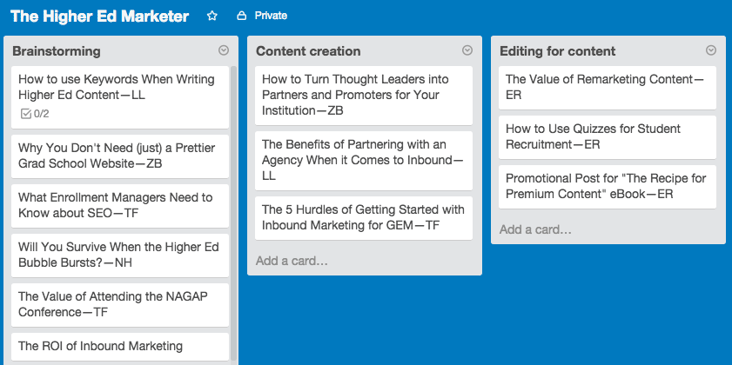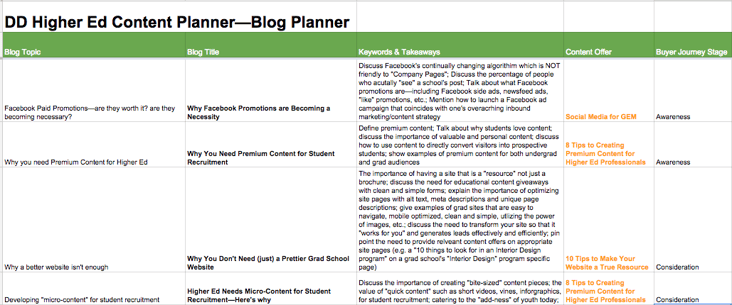What the First 3 Months of Inbound Marketing for Your Grad School Will Look Like

February 17, 2016

Launching an inbound marketing strategy for your grad school is a lot like raising a baby during their first year of life — it’s a heck of a lot of work in the beginning, but becomes more manageable over time (or theoretically should!).
Now, I’ve never raised a child, but as the oldest of six kids, sometimes it feels like I have. As any of you with children know, when your baby is first born he/she takes a lot out of you.
You forget what it feels like to get an uninterrupted night of sleep, you can’t believe the majority of your day is now spent feeding, changing, and calming the little tyke, and a girls’ or guys’ night out seems like something from another lifetime.
But at the same time, this new phase of life is exciting, stretching, and quite rewarding. Seeing your baby lift her head by herself, clap her hands for the first time, and take her first step makes all of the sleepless nights and missed guys’ nights worth it.
At the beginning, inbound marketing is challenging, but as your grad school’s inbound strategy “grows up,” things become easier — and you’re more and more convinced that it was worth it.
Here is what the first three months of inbound marketing will actually look like:
1. Onboarding and Initial Setup
You can’t do inbound marketing without the right marketing platform. While there are a myriad of content marketing platforms out there, we’re huge fans of HubSpot — the folks that wrote the book on inbound marketing to begin with.
Regardless of what platform you choose, you will spend the first few weeks doing the following:
- Setting up subdomains of your website. This is how you’ll be able to easily publish blog posts, landing pages, and premium content without getting your IT folks involved.
- Connecting your social media accounts. Your marketing platform should allow you to schedule, publish, monitor, and analyze how your content is performing across a myriad of social networks and and social network profiles.
- Designing your blog and landing page templates. It’s important that you design and develop templates that are consistent with your school’s brand but are also simple, clean, and clear — you want to make it crystal clear as to what you want visitors to your blog and landing pages to do.
- Brainstorm and finalize your student personas. Simply put, student personas are fictional representations of your ideal student — personas are about psychographics and not just demographics. When you go through the process of establishing student personas, you have to answer more intimate details about the needs, goals, challenges, and preferences of your prospects.
2. Developing a Content Strategy
Since inbound is all about content creation and content promotion, once the initial tech setup is done and your persona development is complete, it’s time to start brainstorming the kind of content your enrollment team wants to develop over the next three months.
Our clients have found creating a “Content Planner” (a glorified Google Spreadsheet) to be extremely helpful in unpacking blog post ideas, developing a vision for infographics, and delegating premium content creation.
If you work with an inbound partner agency, it’s essential that you find time to regularly brainstorm content ideas with them and make them aware of any upcoming events or information sessions that your school might be having.
After you’ve decided what content you want to create over the next 90 days, it’s important to delegate that content. Everyone is busy — and everyone will always be busy. While it is important to give people enough time to churn out a good blog post, it’s crucial to be strict about deadlines when it comes to inbound.
You simply won’t see the kind of ROI you want to see (or your boss wants to see) from inbound after the first twelve months if you’re not producing and promoting enough original content.
Here are a few tips and tools you can use to help you develop and manage your content as you get started with inbound:
- Trello. Trello is a great way to manage the content creation funnel. By setting up boards and cards, you will be able to know where things are at in the pipeline.

- Content planner. As I mentioned earlier, creating content planner that everyone can easily access (like a Google Spreadsheet) will help your team stay on top of deadlines, understand the purpose of each piece of content, and know what persona they are developing the content for.

- Basecamp. Basecamp allows you to both organize and delegate content creation responsibilities to your various team members. Basecamp is where we have our clients share files and keep track of to-do list items.

3. Publishing, Promoting, and Analyzing Your First Pieces of Inbound Content
The beauty of inbound is that it’s all about deciding what content to create based on what the data is telling you your personas are actually interested in. In the beginning, it’s important to publish and promote a variety of content — listicles, infographics, videos, guides, etc. — and see what people actually care about.
Your inbound marketing platform will track every interaction someone has with your content enabling you and your team to know what’s working and what’s not. A lot of the time, our clients are surprised by the content that their personas are actually reading and downloading.
Knowing what different personas care about allows you to create content more intentionally — content that more people in that audience will find valuable.
Start promoting your first pieces of content on Facebook, LinkedIn, and Twitter. You may find that while blog posts tend to get more click throughs and shares on Facebook, your eBooks tend to get more interaction on LinkedIn. This information is highly valuable, as it will help you to decide what content is worth paying to promote on specific platforms.
All of the above can happen more quickly or slowly than 3 months depending on how much of your team’s effort is focused on executing each part. But for most grad schools, it takes about 3 months to build the right foundation for an inbound game plan that will last you at least a year before needing a more advanced strategy.
Like raising a child, inbound marketing is a long-term investment; you’re not going to see ROI overnight. While inbound is a lot of work, with the right team — or agency partners — at your side, it’s a graduate recruitment strategy that is not only sustainable but actually necessary for the twenty-first century.
Want to learn more about launching and inbound marketing strategy for your grad school? Request a free inbound consultation!
.jpg) EBOOK
EBOOK
See how schools are using HubSpot for their enrollment marketing
Service Categories: Enrollment Marketing, Inbound Marketing, Content Strategy, Accessibility








.png)